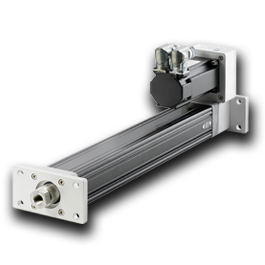Last time in our Block and Tackle Series on “What is a Linear Actuator? we identified the general types of mechanisms that are used to move loads in a straight line. Today’s blog expands on that just a bit with a few more details on the different types used in the motion control world.
 Converting the rotary motion of an electric motor into linear motion is the key to all linear actuators. There are two types of mechanisms for this conversion: lead screw and belt drive. A lead screw is a component that converts rotary motion into linear motion using a screw and nut. As the motor turns the screw, the threads of the screw push the nut along the length of travel. The nut is mounted to a bearing support system to keep it from rotating and allow it to traverse along the axis of the screw. Often, the housing of the actuator is what provides a guide for the nut and whatever the nut is pushing. But many rodless actuators and precision tables use profile bearing rails to support the nut and carriage. The term “lead screw” is a general term to describe a screw that pushes a nut along a length of travel. But lead screws come in two general designs: ballscrew and lead screw (ACME screw).
Converting the rotary motion of an electric motor into linear motion is the key to all linear actuators. There are two types of mechanisms for this conversion: lead screw and belt drive. A lead screw is a component that converts rotary motion into linear motion using a screw and nut. As the motor turns the screw, the threads of the screw push the nut along the length of travel. The nut is mounted to a bearing support system to keep it from rotating and allow it to traverse along the axis of the screw. Often, the housing of the actuator is what provides a guide for the nut and whatever the nut is pushing. But many rodless actuators and precision tables use profile bearing rails to support the nut and carriage. The term “lead screw” is a general term to describe a screw that pushes a nut along a length of travel. But lead screws come in two general designs: ballscrew and lead screw (ACME screw).
Ballscrews consist of a screw and nut with ball bearings inside the nut. This allows the screw to rotate inside the nut with very little friction. It enables a linear actuator to move with very little loss of force due to friction, and allows it to move at higher speeds and longer duty cycles without overheating. However, ballscrews are audibly noisy due to the ball bearings in the nut rattling around.
Lead screws are a much more basic design. The screw threads directly mesh with the nut threads. The ACME screw is a lead screw design with a specific trapezoidal shape to the threads to offer maximum strength. Since there are no bearings in the nut, the threads of the screw and nut are in direct contact, producing significant friction. Friction can be good and bad. For instance, the friction in an ACME nut can allow it to support large loads without the screw backdriving (turning on its own). So it acts like an automatic brake. But the friction also produces heat, which means the speed and duty cycle must be limited to prevent overheating.
 Belt drives consist of a long timing belt that runs around a pulley at each end of a rodless actuator. The pulley at one end is driven by an electric motor, and usually through a gear reducer. The pulley at the opposite end is an idler pulley and usually provides tension adjustment for the belt. This mechanism offers speeds that greatly exceed the maximum speeds of ACME screws and ballscrews. It also runs drastically quieter. If a user is not familiar with the sound of a ballscrew actuator, they will often think something is wrong due to the rattling sound. But belt drives are much smoother and quieter, even at higher speeds.
Belt drives consist of a long timing belt that runs around a pulley at each end of a rodless actuator. The pulley at one end is driven by an electric motor, and usually through a gear reducer. The pulley at the opposite end is an idler pulley and usually provides tension adjustment for the belt. This mechanism offers speeds that greatly exceed the maximum speeds of ACME screws and ballscrews. It also runs drastically quieter. If a user is not familiar with the sound of a ballscrew actuator, they will often think something is wrong due to the rattling sound. But belt drives are much smoother and quieter, even at higher speeds.
Understanding the pros and cons of the mechanisms in linear actuators helps in selecting the appropriate type of actuator to meet specific application requirements. Linear actuators can be used in so many types of applications, including pick&place, pressing, stamping indexer, conveyor diverting, CNC milling, laser cutting, welding, measuring, moving doors and other mechanical linkage control, etc. Each application has requirements that are best suited by certain types of actuators.








